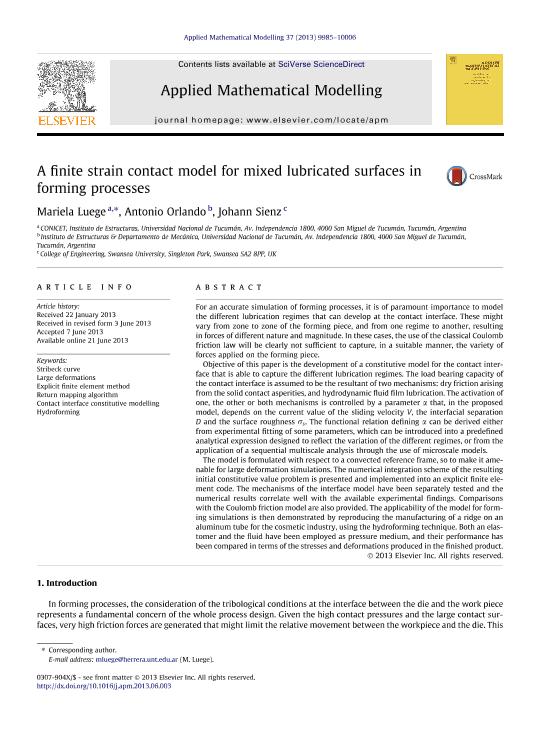Artículo
A finite strain contact model for mixed lubricated surfaces in forming processes
Fecha de publicación:
06/2013
Editorial:
Elsevier
Revista:
Applied Mathematical Modelling
ISSN:
0307-904X
Idioma:
Inglés
Tipo de recurso:
Artículo publicado
Clasificación temática:
Resumen
For an accurate simulation of forming processes, it is of paramount importance to model the different lubrication regimes that can develop at the contact interface. These might vary from zone to zone of the forming piece, and from one regime to another, resulting in forces of different nature and magnitude. In these cases, the use of the classical Coulomb friction law will be clearly not sufficient to capture, in a suitable manner, the variety of forces applied on the forming piece.
Objective of this paper is the development of a constitutive model for the contact interface that is able to capture the different lubrication regimes. The load bearing capacity of the contact interface is assumed to be the resultant of two mechanisms: dry friction arising from the solid contact asperities, and hydrodynamic fluid film lubrication. The activation of one, the other or both mechanisms is controlled by a parameter α that, in the proposed model, depends on the current value of the sliding velocity V, the interfacial separation D and the surface roughness σs. The functional relation defining α can be derived either from experimental fitting of some parameters, which can be introduced into a predefined analytical expression designed to reflect the variation of the different regimes, or from the application of a sequential multiscale analysis through the use of microscale models.
The model is formulated with respect to a convected reference frame, so to make it amenable for large deformation simulations. The numerical integration scheme of the resulting initial constitutive value problem is presented and implemented into an explicit finite element code. The mechanisms of the interface model have been separately tested and the numerical results correlate well with the available experimental findings. Comparisons with the Coulomb friction model are also provided. The applicability of the model for forming simulations is then demonstrated by reproducing the manufacturing of a ridge on an aluminum tube for the cosmetic industry, using the hydroforming technique. Both an elastomer and the fluid have been employed as pressure medium, and their performance has been compared in terms of the stresses and deformations produced in the finished product.
Archivos asociados
Licencia
Identificadores
Colecciones
Articulos(CCT - NOA SUR)
Articulos de CTRO.CIENTIFICO TECNOL.CONICET - NOA SUR
Articulos de CTRO.CIENTIFICO TECNOL.CONICET - NOA SUR
Citación
Luege, Mariela; Orlando, Antonio; Sienz, Johann; A finite strain contact model for mixed lubricated surfaces in forming processes; Elsevier; Applied Mathematical Modelling; 37; 24; 6-2013; 9985-10006
Compartir
Altmétricas




